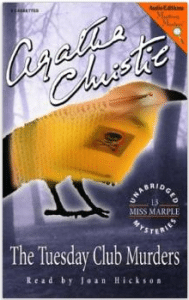 13 Titillating Miss Marple Mysteries
13 Titillating Miss Marple Mysteries
Author: Agatha Christie
Driving home through a cold, blustery winter’s eve the grey horizon fading into night as the ice pelted against my hood, I kicked back and praised the traffic jam as Joan Hickson read The Tuesday Club Murders, a collection of thirteen Miss Marple short stories. Sitting around the fire after Sir Henry Clithering’s retirement from Scotland Yard the conversation turns to crime and murder and a challenge is issued. Each Tuesday one member of the gathering will relate a true mystery and the others will be compelled to use their wit and dedication to unravel the crime. Miss Marple, a wily spinster, may not have traveled much but no one can supersede her keen understanding of human nature and how despite the change of scenery, people never change.
The stories are atmospherically rich, oddly cozy and yet ruthlessly intriguing and gritty. We have The Idol House of Astarte related by the parson (my personal favorite tale) of a haunted grove with an idol to Astarte where during a fancy dress ball at moonlight a man is murdered, seemingly by the vengeful gods of old. In Ignots of Gold a sunken Spanish galleon and a greedy Lord lead Raymond West to speculate about the nature of conniving greed; Joyce Lemprière, the artist, relates her story in The Blood Stained Pavement, an ancient intrigue with modern murder as a man, his wife, and his old school friend are inexplicably involved in a drowning that Joyce sees first through her painting. Motive VS Opportunity is a legal thriller of trust, family, and last wills focusing on a clever trick that is so simple it proves almost undetectable. The Thumb Mark of St. Peter, the last of the actual Tuesday Club mysteries, is related by Miss Marple herself and follows a titillating story of murder, madness, and a strange ingredient of death.
The second portion of the short story collection continues the theme of a narrator describing a real life mystery aloud as the group of artists and other clever intellectuals attempt to unravel the complicated and great unsolved crimes of their days; the scene shifts to the dinner table and the course of tales begins with The Blue Geranium, a mysterious narrative involving a fortune teller, a warning, and wallpaper that changes colors as a dire end comes closer. The Companion follows with a story of deceit, drowning, and hidden identities. Sir Henry Clithering tells The Four Suspects, a story involving four suspects all very close to one victim – a man none of them would ever betray – with time running out, unproven suspicions are destroying the innocent. A Christmas Tragedy is another story straight from Miss Marple, involving quite an in-depth and ingenious plot as Miss Marple herself becomes temporarily perplexed by the savvy mannerisms of a clever killer who is on to her suspicious from the beginning. Next, we have The Herb of Death where a killer seemingly poisons many just to kill one and, somehow, gets away with it. The Affair at the Bungalow breaks from the theme of long unsolved mysterious that finally have definitive answers as a schemer tries out an unwieldy plan before executing it and finally, in the last story of the collection, Death by Drowning, readers are thrown into a present mystery as Miss Marple unveils a killer in their midst after a supposed suicide is reported in the village.
Short and succinct, each story is a bite sized mystery, elegantly interwoven with the density of a deep drama, revealing Agatha Christie’s talent and her scope of characterization. Having read several full length Miss Marple mysteries, I was astonished that each short tale, some only a few minutes in length, encompassed a complete tale which didn’t feel negatively impacted by the length. Indeed, the shortness of the stories pushed readers immediately into the atmosphere with each cast of characters revealed through a rapt audience’s attention and interaction with the story teller. This atmosphere evokes the oral tradition of storytelling and the lively tension of being in a story and watching how it changes and morphs as each unique voice adds theories and asks questions.
Christie’s command of language enables readers to keep speakers separate and just as each story fits together in the overall theme, they are all separate and decidedly their own story told in subtle but unique ways that evoke a drawing room full of people, querying the strangeness that has touched their lives and rooting out the heart of evil. Readers are immersed as language, specifically dialogue, becoming another figure in that drawing room of cozy intellectual stimulation with that sharp, biting edge of gruesome reality and the nefarious nature of selfish humanity. Sure to capture readers who love a good mystery, Christie proves herself once again as not only the master of mysteries, but of the short story form. Highly recommended.
*Note on the Audio Book: The audio book read by Joan Hickson is an enjoyable companion for daily commutes; Hickson’s voice fluctuates to emphasis character and voice. She creates an atmosphere and makes it come alive. Yet, the voice has a very old quality to it, a certain slurring of words that evokes the elderly Miss Marple well, but is a little distracting for other characters.
- Frances Carden

Leave A Comment